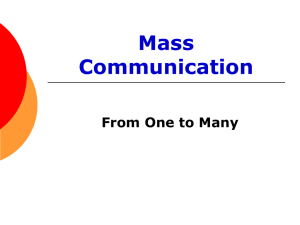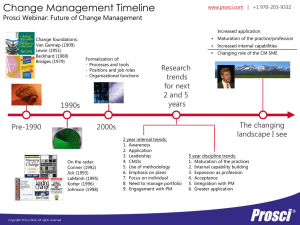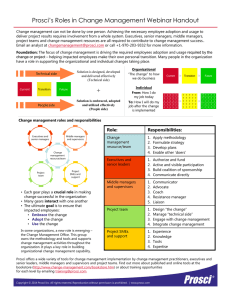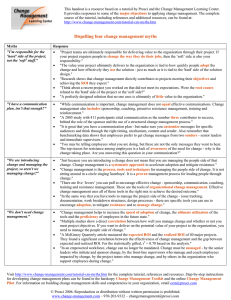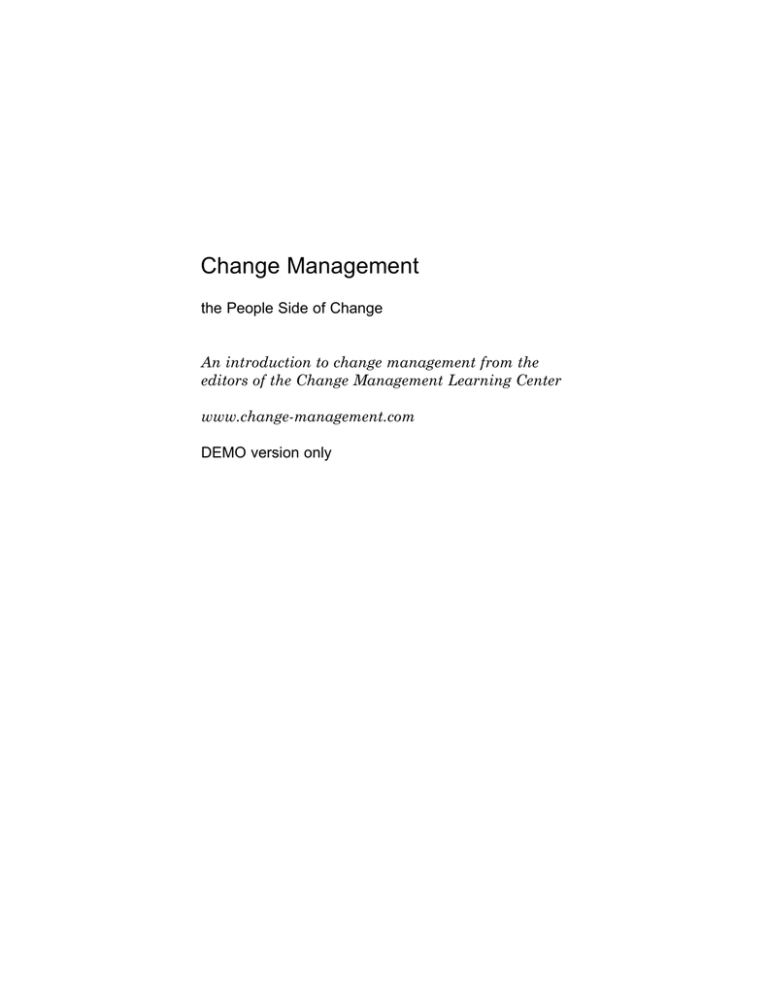
Change Management
the People Side of Change
An introduction to change management from the
editors of the Change Management Learning Center
www.change-management.com
DEMO version only
Advance praise for Change Management:
the People Side of Change
“Great book! This book takes the sometimes overly academic
work around change management and makes it easy, understandable and actionable.”
Laura Roethe, Change Management Practice Leader,
CUNA Mutual Group
“The principles illustrated in the book are timeless and appropriate to any condition where things are not static. In fact, they
are based upon great quantities of common sense – so much so
that their utilization is not common.”
Kim A. Kennedy, General Manager,
Industrial Operations, Blue Diamond
“This is a must read. Recognizing the need for change and effectively leading the correct changes may be the most important
leadership role for today's executives. In today's competitive and
uncertain economic environment, change competency may be the
key to success.”
E.H. (Gene) Sherman, Founder and CEO,
Baynard Cove Group
“Great book on change management – especially the ideas presented on integrating the organizational and individual elements
of change management. The book has forced me to look at change
management in a new way!”
Susan L. Schleusner, Project Manager,
Storage Technology Corporation
“A wonderful primer for change management. Every organization, both public and private, should view this text as required
reading before implementing major change.”
Dr. James Johnson, Adjunct Faculty,
Regis University
“Change Management is a great book to read if your boss ‘talks’
about change management, but can't explain what change management is or how to go about it. This book will give you the foundation you need to manage change and get the results you are
trying to achieve.”
Melissa Dutmers, Process Architect,
Agilent Technologies
“Change Management is like a driving school for change agents.
It teaches you the basic principles and rules for safely navigating
changes and offers you insight into the minds of other ‘drivers.’
This book allows professionals to manage change so that whatever change ‘vehicle’ your company chooses to drive, you will be
able to efficiently and effectively get to wherever your company
wants to go.”
Michelle Wiginton, Information Technology,
University of Oklahoma
“What impressed me the most in the book is the concept of
change competency – the idea that change becomes business as
usual. This opened my eyes to the fact that business and process
changes must happen fast and are continuous.”
Linda Colston, Process Development Specialist,
Nokia
“By far the greatest strength is in the integration of the change
process on two levels: the individual and the organizational
(business). Far too often, publications have emphasized one at
the expense of the other, leaving the integration to change management students with no guidance.”
Norma Sutcliffe, Ph.D., Assistant Professor,
DePaul University
Change Management
the People Side of Change
An introduction to change management from the
editors of the Change Management Learning Center
www.change-management.com
Jeffrey M. Hiatt
Timothy J. Creasey
Prosci Learning Center Publications
Copyright 2003 by Prosci
All rights reserved.
First edition
Printed in the United States of America
Library of Congress Control Number: 2003111671
Hiatt, Jeffrey M., Creasey, Timothy J.
Change Management: the People Side of Change
p.
cm.
ISBN 1-930885-18-0 paperback
ISBN 1-930885-19-9 hardcover
1. Organizational change - Management 2. Project
management 3. Psychology - Change. I. Title
HD58.8 2003
658.4’06--dc20
Prosci Research
Loveland, Colorado, USA
Cover design by Larissa Carlson
All rights reserved. No part of this material may be reproduced or transmitted in any form or by any means,
electronic or mechanical, including photocopying, recording, or by any information storage or retrieval system
without written permission from Prosci, except for normal reviews and quotations.
The paper used in this publication meets the requirements of the American National Standard for Permanence
of Paper for Printed Library Materials Z39.49-1984.
Volume discounts and direct orders are available from Prosci Research by calling 970-203-9332 or by visiting
www.change-management.com
Contents
Chapter 1 - Why manage change?
1
Chapter 2 - Theories and principles
13
Chapter 3 - Individual change management
45
Chapter 4 - Organizational change management 61
Chapter 5 - Change competency
83
Chapter 6 - Conclusion
91
Appendices
Appendix A - Change management resources
97
Appendix B - ADKAR worksheets
107
Appendix C - Highlights of best practices
123
Appendix D - Frequently asked questions
137
CHAPTER 1
Why manage change?
As editors of the Change Management Learning Center,
we have analyzed research data from more than 1,000
companies involved in large-scale changes. We talk daily
with project leaders and managers. We write weekly articles and tutorials on managing the people side of change.
We review new books in this field of study. What we
observe more than anything else is the need for easy-toapply concepts and practical guidelines for managing
change. Yet, up to now, a straightforward introduction to
change management has not been available.
When finished with this book, you will have a basic
context for change management, know why it is important
and understand how it is used. As a business manager, you
will be more effective as a change leader and sponsor of
change. Specifically, you will be able to prevent and manage resistance to change, minimize productivity loss,
avoid unnecessary turnover and increase the probability that your business changes produce the desired
results.
1
2
Change Management
Why manage change?
Whether you are an executive, supervisor, coach, consultant, project team leader or manager of any type where
your job is to manage people, you likely have experienced
resistance to change from employees. However, you may
not recognize the role that you can play in preventing that
resistance and leading change. Most managers do not
make this connection until they have personally experienced failure in an important change project.
“I should have communicated better.”
“Next time I will involve more people.”
“If the CEO had just been more public in his
support.”
“I was undermined by managers who felt threatened
by this change and did not understand the vision.”
These common reflections by business leaders after an
unsuccessful initiative have one common theme: each represents a failure to manage the people side of change.
They are not alone. In a general study1 of companies
implementing major business changes, 327 project leaders, consultants and managers answered the following
question about their project overall:
"If you had the chance to do it again,
what would you do differently?"
The most common response was:
Chapter 1 - Why manage change?
"Utilize an effective and planned
change management program."
Surprisingly, these study participants did not emphasize
design or technology issues. They did not say they lacked
vision or an understanding of the marketplace. The most
common barrier to success was a lack of change management. They fell short when managing the people side of
change and encountered:
1. Managers who were unwilling to assign the needed
resources to the project or would not allow their
representative adequate time to participate
2. Managers who filtered out important messages or
started negative conversations about the change
3. Employees who became distracted and lost interest
in their current work responsibilities thereby
impacting overall productivity and customers
4. Valued employees who left the organization
5. More people taking sick leave or not showing up for
work
6. Unforeseen obstacles to the change that seemingly
appeared from nowhere
7. A lack of funding for the change
In other words, things did not go exactly as planned. The
unexpected happened. Not managing the people side of
change impacted their success and introduced risk into
3
4
Change Management
their projects.
Change management can not only mitigate these
business risks, but in many cases avoid them entirely.
Business leaders have the potential to not only manage
resistance once it appears, but to prevent it in the first
place. Unfortunately, many business leaders and project
teams do not appreciate their role in managing the people
side of change until after resistance impacts the success
of their change.
Two case studies show the potential consequences of
not managing the people side of change. These case studies were selected because they highlight two common
leadership mistakes: first, believing that change management is someone else’s job; second, ignoring the people
side of change until major resistance stalls a project or
causes the project to fail.
Case Study 1 - The Reluctant CEO
To reduce cost and improve customer service, an insurance company wanted to consolidate its customer contact
centers across several divisions. A consultant was hired to
support the effort and to prepare implementation plans.
The project no more than began when rumor spread
through several departments that this organizational
change was not good for the company. Supervisors and
key managers in the existing customer care centers began
resisting the change. In some cases they would not show
up for design reviews or miss key decision-making meetings. Information requested by the consultant and the
design team was withheld or half-complete. At breaks and
around the coffee pot, employees complained about potential leadership changes. Both employees and managers
Chapter 1 - Why manage change?
were distracted from their day-to-day work and productivity suffered. Key managers were rumored to quit if the
change was implemented. The consulting firm met with
the CEO, repeatedly warning that this resistance would
undermine his change and would ultimately begin to
affect customers. The CEO, however, was reluctant to
become personally involved. He believed that change
management was the job of his project team and the consultant, and not the responsibility of the head of the company. After several months of difficulties and delays, the
consultants finally declared the consolidation in jeopardy.
With the project at a stand-still, the CEO requested
an emergency briefing with his leadership team. To prepare for this status report, the consultants conducted
interviews with key managers throughout each department. They quickly identified a director in an existing
customer care center who viewed his job at risk with the
potential change. Negative conversations initiated by this
director were spreading throughout the ranks. His supervisors were the same people who were presumably threatening to leave the organization.
Even armed with this information, the CEO
remained reluctant to take definitive action. The only
recourse at this stage was reassignment or termination of
this manager. Both options could have negative fall-out
for the company and the affected manager. The CEO was
faced with a stalled project and a potentially lose-lose
decision for a long-tenured manager.
In this case, the CEO made two mistakes that are common in major changes. The first was to assume that
change management was someone else’s responsibility. In
a change management benchmarking study with 288
companies,2 the number one research finding related to
5
6
Change Management
an executive’s role in change is active and visible sponsorship at every phase of the project. The second mistake
the CEO made was not managing resistance when it first
surfaced. Resistance to change can spread like wildfire
when not managed effectively. Waiting, in this case, only
resulted in a more difficult situation later on.
Case Study 2 - Stripes and Tar
The president of a business association had facilities
maintenance as part of his overall responsibilities. The
association included multiple businesses that each had
condominiums in a single large office complex. The president of the association decided that the parking lot needed resurfacing and new striping. He arranged for a local
contractor to do the work.
One day the construction company showed up at the
office complex and started blocking off the parking lot.
The contractor was getting his equipment ready and was
trying to clear the lot of cars when disgruntled business
owners confronted his workers. The business owners
wanted to know what was happening, why it was happening and who authorized the work. Not happy with the
uninformed answers from the contractor and the immediate demands to remove the cars from the lot, the business
owners instructed the contractor to pack up his equipment and leave. Since the president was not on site to
resolve conflicts, the contractor had no choice but to abandon the job.
Even when the president finally intervened later in
the day, enough business owners were upset about the
unknown financial impact and the disruptive process that
the contractor never returned to resurface the parking lot.
Chapter 1 - Why manage change?
In this case, the association president knew what needed
to be done, took charge and moved ahead. The change was
small, and in terms of maintenance, he was doing the
right thing for the association. However, the president
neglected to make the business owners aware that the lot
needed resurfacing as part of normal maintenance. He did
not communicate the financial benefit to the association
and therefore the financial benefit to each business
owner. Finally, the president did not inform the business
owners about how and when the work would be done, and
what the business owners needed to do to support the
project. The result was resistance from the business owners, who, in this case, had sufficient authority to stop the
work. The association president simply ignored the people
side of the change and the project failed.
Both complex and simple changes can fail. With
many projects, the evidence of failure from not managing
the people side of change is not as black and white as the
absence of new blacktop with freshly painted white lines.
Failure can come in many forms including project delays,
loss of valued employees, significant declines in productivity and customer dissatisfaction.
In Case Study 1, the CEO did not think that managing change was part of his job. It was not until a crisis
emerged that the CEO became involved. In Case Study 2,
the association president viewed the change as small and
simple, a change that he did not think required change
management.
Why do many business leaders believe that managing the
people side of change is not their job? At the onset of a
new change, managers are typically focused on issues
besides change management. Executives want the change
to happen as soon as possible. Their focus is on results.
7
8
Change Management
They are aware of the business issues facing the organization and are accountable for financial performance.
When a change is needed, they want action quickly. Their
primary concerns are:
•
What is the required investment?
•
How will this change impact our financial
performance?
•
What is the return on this investment?
•
When can the change be completed?
•
How much improvement will be realized?
•
How will this change impact our customers?
If the answers to these questions are favorable, then the
directive to a project manager or project team is typically
"let’s get it done." The executive’s focus is not on change
management.
The perspective of front-line employees (and in many
cases their supervisors and managers within the organization) is very different. They generally do not have
detailed insights into the business strategy and financial
performance of the business, nor do they share the same
accountabilities as business leaders. Many employees
cannot connect what they do everyday with the performance of the company; therefore, it is difficult to convince
them to change based only on company performance.
Their focus is on the day-to-day job. Serving customers,
processing orders, getting their work done – these are
their primary areas of interest. When a change is made,
Chapter 1 - Why manage change?
their primary concerns are:
•
What will this change mean to me?
•
Will I have a job?
•
Do I have the needed skills and knowledge to
succeed in the new environment?
To complete the picture, consider the consultants or project team who encounter both of these different perspectives yet have the job to design and implement the
change. They are accountable to the business leaders that
authorized the change, yet must work with employees to
implement the change successfully.
Employees, the project team and executives have different priorities, different knowledge sets and different
motivations. Change brings these different priorities,
knowledge sets and motivations together in a potentially
volatile mix. Employees feel threatened. Executives
expect results. The project team is caught in the middle.
The business enters a period in which the risk of productivity loss, customer dissatisfaction and employee
turnover increases dramatically. It is at this critical juncture that change management plays a crucial role for
business success.
To survive in today’s marketplace, a business must
constantly examine its performance, strategy, processes
and systems to understand what changes need to be
made. At the same time, an organization must also understand the implications of a new business change on its
employees, given their culture, values, history and capacity for change. Employees ultimately perform the new
day-to-day activities and make the new processes and sys-
9
10
Change Management
tems come to life in the business. Change management is
about managing people in a changing environment so that
business changes are successful and the desired business
results are realized.
The challenge for today’s leaders
These two views of change, the top-down executive’s view
and the bottom-up employee’s view, create two distinct
challenges for managing change. These two challenges
can be referred to as organizational change management
(from the manager’s perspective) and individual change
management (from the employee’s perspective). Both are
skills that today’s leaders need for success.
Organizational change management is the perspective of business leadership from the top looking down into
the organization. The focus is around broad change management practices and skills that will help the organization understand, accept and support the needed business
change. The emphasis is on communications, training and
the overall culture or value system of the organization.
Individual change management is the management
of change from the perspective of the employees. They are
the ones who ultimately must implement the change. The
focus for individual change management is around the
tools and techniques to help employees through the transition. Managers and supervisors must provide the coaching required to help individuals understand their role and
the decisions they make in the change process.
Overall, change management is about helping people
through change. It is the process, tools and techniques for
proactively managing the people side of change in order
to achieve the desired business results.
Chapter 1 - Why manage change?
Getting up to speed
Change management is the application of many different
ideas from the fields of engineering, business and psychology. As changes in organizations have become more frequent and a necessity for survival, the body of knowledge
known as “change management” has also grown to encompass more skills and knowledge from each of these fields of
study. While this may be a good trend overall, the result for
many business leaders is growing confusion about what
change management really is.
The purpose of this book is to bring the meaning of
change management into focus. Written for executives,
managers and consultants, this book will provide you with
a solid understanding of the principles and processes
around managing change in today’s competitive environment. Case studies, examples and even a personal exercise
will help bring the concepts to life.
A different change management definition
The software and IT community have long used the term
“change management” to refer to the processes and systems of managing software and hardware revisions (also
referred to as change control). If you conduct a search on
an internet search engine under the term “change management,” you will find mixed listings. Some listings are
for change management as defined in this book. Other
listings are for software and hardware change control.
This is an unfortunate collision of two fields of study
using the same terminology to refer to two completely different topics. However, the IT community is often
involved in major business change projects, and therefore
11
12
Change Management
as a practitioner you must be sure that your team understands change management as it is being applied for your
project.
Moving forward
Before jumping into the models for individual change
management and organizational change management, we
have devoted a chapter to the principles and theories that
contribute to the current thinking on managing change.
These principles will provide a foundation for the models
presented later in this book.
References
1.
Prosci. (2002). Business Process Reengineering Benchmarking
Report. Loveland, CO: Learning Center Publications.
2.
Prosci. (2003). Best Practices in Change Management. Loveland,
CO: Learning Center Publications.
CHAPTER 2
Theories and principles of change management
Most change management models in use today are in the
form of a process or set of steps. These processes or activity lists were developed through trial and error, and are
based on experiences of experts in the field of change
management. In some cases these experts have created a
standard process based on their consultancy models.
These experts often use the same processes with their
clients that are published in their books, articles and
training materials.
Unfortunately, the underlying lessons and principles
that resulted in these change management processes are
not always clear. In many cases the principles are not
even discussed as part of the resulting model. In a sense,
what you learn is the how but not the why. The years of
practical experience and knowledge that formed the base
for these processes are not readily available to business
managers.
A story about a young man watching his mother prepare a roast illustrates the importance of this point. Each
time his mother cooks a pot roast, she cuts two inches off
13
14
Change Management
each end of the roast.
The son asked, “Mom, why do you cut the ends off?”
“I don’t know,” replied Mom, “that is the way
Grandma always did it.”
The son decided to investigate with a series of phone
calls first to Grandma, then to Great Grandma. Grandma
said she did it just the way Great Grandma showed her.
After talking with Great Grandma, the son discovered
that she cut the ends off the roast because her oven and
cooking pan were too small, and she had to cut the ends
off to make it fit.
Mom and Grandma knew the how – cutting two inches off each side of the roast – but not the why – because
the original pan was too small. Ovens and pans are larger now and it is no longer necessary to shorten the roast.
Understanding the why makes you better at doing
the how. Change management is not a matter of simply
following steps. Since no two changes are exactly alike,
following a recipe for change management is not enough.
The right approach will be specific to the situation. If you
do not understand the why, changes can fail even when
standard processes are followed. Research with hundreds
of project teams has shown that a one-size-fits-all
approach is not sufficient. To be effective at leading
change, you will need to customize and scale your change
management efforts based on the unique characteristics
of the change and the attributes of the impacted
organization.
To accomplish this customization, an understanding
of the psychology of change and key guiding principles is
vital. You will then be able to work with many change
management methodologies and adjust your approach
according to the size and nature of the change, ultimately making your change a success.
Chapter 2 - Theories and principles
Primary principles for change management
The guiding principles that will impact your change management activities are shown in Figure 1. The overview of
principles and ideas presented here is not intended to be
an in-depth psychological analysis. Rather, the focus will
be on the key insights from these principles that impact
effective application of change management. Case studies
are used to illustrate key messages including how one
million dollars in cash served as a change management
tool.
Senders and
receivers
Resistance and
comfort
Change is
a process
Change
Principles
The right
answer is
not enough
Authority for
change
Value systems
Incremental vs.
radical change
Figure 1 - Primary change management principles
15
16
Change Management
Principle 1 - Senders and receivers
Every change can be viewed from the perspective of a
sender and a receiver. A sender is anyone providing information about the change. A receiver is anyone being given
information about the change.
Senders and receivers are often not in a dialogue at
the onset of a change. They often talk right past one
another as shown in Figure 2. What a sender says and
what a receiver hears are often two very different
messages.
Business issues and need to change
Senders
Personal implications and risk
Receivers
Figure 2 - Sender and receiver disconnect
For example, if a supervisor sits down with an employee
to discuss a major restructuring project within the company, the supervisor may be enthusiastic and positive.
She may cover all the key messages including the business reasons for change, the risk of not changing and the
urgency to change the organization to remain competitive. The supervisor may even emphasize that this is a
challenging and exciting time. However, when the
Chapter 2 - Theories and principles
employee discusses this change at home over dinner, the
key messages to her family are often:
“I may not have a job.”
“The company is having trouble.”
The supervisor may spend 95% of the conversation talking about the business and 5% talking about the implications to the employee. At home, the employee is more likely to spend 95% of the time talking about the impact on
her personally and 5% on the issues facing the company.
The consequence is that much of the key business
information communicated by the supervisor to the
employee in this first conversation is not heard. It is overshadowed by concerns related to job security and fear
about change.
Many factors influence what an employee hears and
how that information is interpreted. Examples of these
factors include:
•
Other career or educational plans
•
Situations at home or with personal relationships
•
Their past experience with other changes at work
•
What they have heard from their friends or work
colleagues
•
Their current performance on the job
•
Whether or not they trust or respect the sender
17
18
Change Management
Now multiply these factors by the number of employees
who are the receivers of change messages, and add even
more variables as each person could have a different
agenda. You can begin to appreciate the challenge faced
by many businesses as they communicate the change to
their employees.
Preferred senders
Based on Prosci’s change management research study
with 288 organizations,1 employees prefer two primary
senders of change messages. Not surprisingly, they also
prefer specific message content from each of these
senders. Immediate supervisors are the preferred senders
of messages related to personal impact including:
•
How does this impact me?
•
How does this impact our group?
•
How will this change my day-to-day responsibilities?
When it comes to personal issues, receivers want to hear
from someone they know and work with regularly, namely their supervisor.
CEOs or executive leaders are the preferred senders
of messages related to business issues and opportunities
including:
•
What are the external customer and competitor
factors driving this change?
•
What are the current issues facing the business?
Chapter 2 - Theories and principles
•
Are there other marketplace drivers?
•
What are the financial risks if we do not change?
When it comes to business issues and why the change is
needed, receivers want to hear from the person in charge.
The sender and receiver concept is very relevant to
the actions taken by change management teams, project
teams and business leaders in the change management
process. Typically, executives, project teams and supervisors are the senders of key messages. They follow a prescribed communications plan to share information about
the change. These communication activities are part of
organizational change management.
In some cases, however, managers do not assess what
their employees actually heard, nor do they understand
how that information was processed. They merely complete a communication activity, check off a box, and move
on to the next activity. A poor assumption is that “employees heard just what I said and understood exactly what I
meant.”
More likely, employees heard only a fraction of what
was said, and their translation of that message will be
unique to their personal situation. Some employees may
have heard more than what was said, or will make up
answers to questions that they do not understand. The
answers they make up are typically worse than reality.
Realizing that what receivers hear and what senders
say is not always the same is the first step to understanding that change management cannot be reduced to a set of
activities or steps. Managers must not only be clear in
their communications, they must also listen to employees
to understand how their messages are being received.
Change management communication is only effective
19

